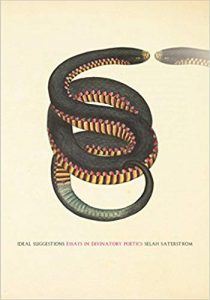by KYLAN RICE
Selah Saterstrom, Ideal Suggestions: Essays in Divinatory Poetics. Essay Press, 2017, pp. 290
The poets’ rightful mood is ecstasy. Poets dwell in ekstasis—that is, outside themselves, bodies without organs, effusing their very flesh “in eddies and…in lacy jags” (Whitman, “Song of Myself”). Metastasized, the poet has no identity, or so John Keats claimed: “As to the poetical Character itself…, it is not itself—it has no self—it is everything and nothing—It has no character—it enjoys light and shade.” Loosed among things and persons, the poet “is continually in for and filling some other Body.” The poet extrudes, drifts, lingers for a time, pollinates—theirs the ekstasis of an outborne velocity.
Yet, Keats also says that he would “rather be the flower than the Bee, for it is a false notion that more is gained by receiving than giving.” The bee moves ecstatically abroad, attracted and displaced, continually filling the calyx, the other body, enjoying light and shade. The flower, on the other hand, remains rooted, exposed, taking in the bee so as to be taken from. The flower is a site, not a line of flight.
Moreover, is not the flower known? Is not the flower precisely an identity, furled, spotted, and colored just so as to attract with patterns the appropriate pollinator? The flower receives, too, as Keats observes, its own “fair guerdon from the Bee.” And so, poet, be like flower—be “passive and receptive, budding patiently under the eye of Apollo and taking hints from every noble insect that favors us with a visit.”
The flower is able to receive on condition of identity. This principle extends more generally to other cases of reception. German literary historian Hans Robert Jauss, for example, theorizes the “horizon of expectations” that governs the reception of a text by a reader. This horizon is made up of life experiences, cultural inheritance, and historical precedent—the amalgamated particularities, in other words, of a personal identity.
So it is personal to receive—less ekstasis than intimacy. The poet doesn’t leave herself; the poet is approached as a function of her individual disposition. In her new book Ideal Suggestions: Essays in Divinatory Poetics, Selah Saterstrom compares being a poet to the work of doing divinatory readings, arguing that “being an effective reader is contingent upon the quality of presence with which one positions oneself in the constant stream of information and texts.” Both medium and poet are receptive only insofar as they rely on “quality of presence” and “position” to channel the constant ecstasy of information and texts. The poet is no go-between, but the in-between itself, the medium. Saterstrom cites poet and translator Christian Hawkey on this topic: “Consciousness is less a vehicle for self-presence than a void, a blank space at the site of intersection.” The poet is a “crossroads”—an intersection, an invitation, a self-prepared interior.
Opening her book by synchronizing the work of the poet and the medium, Saterstrom proceeds to offer a series of “essays” or “attempts,” making use of the original French sense of the word essai. Much, but not all, of Ideal Suggestions takes the form of prose poetry, though Saterstrom chooses to describe even her most disjunctive, paratactic texts as essays “in so much as they attempt a divinatory poetics.” She states that “by employing various divinatory generators (instructions, methods, and trances),” she seeks “to enter the flux and sing out loud some of the animated strands of potential” that she sees “inside an illuminated intricacy,” by which she means her life, or any life, or “the life of others.” In her essays, Saterstrom shows what it means to participate (or to read and write) “from within the membranous precincts between our multiple bodies in the larger rhizomic field of resonances, where much is sounding and is also unsounded.” These essays are attempts to position the self as a receptive presence in order to “sound” out what is already there, between us—a membranous rhizome.
Indeed, the rhizome as described by French philosophers Gilles Deleuze and Felix Guattari hangs above the whole of this book as its unspoken, unspeakable icon. Like Keats, Deleuze and Guattari have also addressed the reciprocal relationship between flower and bee, sender and receiver, formulating the pair instead as an orchid and a wasp. As an image of rhizomatic relationality, integral correspondences inhere at the most essential strata of both wasp and orchid. They are knotted together. Their relationship fuses each to the other metamorphically, on both formal and functional levels. Deleuze and Guattari call the shifting, fluctuating series of identic de- and re-formations that bind these two entities together a process of “territorialization” and “deterritorialization.” These terms signify modes of dynamic relation, which Deleuze and Guattari describe in the following excerpt from A Thousand Plateaus:
The orchid deterritorializes by forming an image, a tracing of a wasp; but the wasp reterritorializes on that image. The wasp is nevertheless deterritorialized, becoming a piece in the orchid’s reproductive apparatus. But it reterritorializes the orchid by transporting its pollen. Wasp and orchid, as heterogeneous elements, form a rhizome. … At the same time, something else entirely is going on: not imitation at all but a capture of code, surplus value of code, an increase in valence, a veritable becoming, a becoming-wasp of the orchid and a becoming-orchid of the wasp. Each of these becomings brings about the deterritorialization of one term and the reterritorialization of the other; the two becomings interlink and form relays in a circulation of intensities pushing the deterritorialization ever further. There is neither imitation nor resemblance, only an exploding of two heterogeneous series on the line of flight composed by a common rhizome …
Saterstrom channels Deleuze and Guattari’s image of the wasp and orchid as a means of making sense of the relationship between poet and “the larger rhizomatic field of resonances” in which she labors. It turns out that in Ideal Suggestions, the poet is no less flower than bee, since both sender and receiver of occult messages are constantly territorializing on each other, present to one another in an ontological feedback loop. “Ontology,” of course, is the wrong word here, since it signifies a stable mode of Being, while Saterstrom, Deleuze and Guattari are more interested in the essential “becoming” that deforms and reforms entities or presences along schizoid lines of flight. Both the poet and the presences they summon are in the process of intimately becoming each other. Reception is a risky process of changing and being changed at profound psychic levels.
Images of orchids and wasps appear in the final prose-poetic essay of the book, “On Ideal Suggestions When Brain-Photographed Through the Paintings of Matthias Grunewald.” Saterstrom describes the piece as an “ecstatic song” that attempts self-healing after the suicide of her grandfather. As an attempt to heal or redeem, the essay is an example of divinatory poetics, helping to “translate the world back into tongues (an event that can help one stay in a body and in a life)” by triangulating congruencies and consistencies at the level of language and of experience:
Let us say lovers separate: the orchid and wasp.…Let us say that what we dwell upon, we become, or at least God, if it be God, moves across the waters….Let us say thought-messages sent in any direction come back. They are like light in mirrors. Opposites vanish. Lower forms are kindergartens for broader manifestations. Let us say this is electricity. To the deceptive and sensuous, the concept of divine influx causes dinner parties: life is continuous communication. Exuberance fills every space not closed against it. Let us say I let it possess me. It overflows so that I give it to those around me. This is called waiting. And Lover is the name.
In some of her most lucid terms, Saterstrom here epitomizes a number of the central themes of Ideal Suggestions as a whole. Importantly, the ecstasy or the “exuberance” of the poet permits possession, while also dissolving “opposites.” Additionally, using language that signals reciprocal forms of relation, Saterstrom makes metaphysical claims about the “membranous precincts” of correspondences that shape a vital macrocosm. The poet has arrived at these visions through a special series of divinatory writing exercises and exorcisms.
In another passage that seems to imagine rhizomatic forms of becoming, Saterstrom describes the limits, doubling as the possibilities, of divinatory writing. Writing becomes a means for getting beyond writing in order to encounter the other’s nearby life:
the radicalizing effect of immediacy deforms mouths, our mouths deformed writing describing the effect radicalizing the writing describing our mouths and so we move (closer).
The poet is formed and deformed by their writing, which de- and re-territorializes intimate, immediate relationships between language and environment. A divinatory poetics is about using writing to divine, read, or prophesy new forms of proximity or becoming-among.
When writing is conceived in these terms, as a kind of reading of physical as well as spectral environments, it becomes “an embodied hermeneutics, an ontological situation.” Writing becomes a total mode of living as knowing. Since embodied, situational writing is an open process as much as a process of opening, of becoming radically available to presences other than one’s own self-presence, the life-knowledge made available by Saterstrom’s “divinatory poetics” is inconclusive, indeterminate, peripheral. Like Kathleen Stewart’s “ordinary affects,” which Saterstrom cites in her introduction, the forms of knowledge made available by a divinatory poetics are not meaningful per se. Instead, knowledge takes shape as a “density” or “texture” that “give[s] everyday life the quality of a continual motion of relations, scenes, contingencies, and emergences”—a build-up of “impulses, sensations, expectations, daydreams, encounters, and habits of relating…”. Saterstrom takes up these densities and textures and tries to find the occult relays running through them, connective networks that appear then disappear, often leading to dead ends or ends unforeseen and sometimes unwelcome.
The honesty with which this book owns up to its own knowing looseness is one of its best features. Saterstrom records her own wandering, transient writing process, witnessing to the often multi-authored, ad hoc, and irrational qualities that lay beneath the final version of any given text. For example, in the introduction to one of her essays, Saterstrom tells a story about her divorce which she loosely associates with the parallel hardships of a distant friend, named Rachel. Having woven these two narratives over the course of a few pages, Saterstrom finally writes “It is important to include this story about Rachel, her divorce, and what she said to me that day as I sobbed on the broken green couch, but it is also true that now I cannot remember wholly why. It’s like an anecdote that has lost its way, wandering around the mall in a nightgown at night. There was an urgency to include this story earlier in this essay’s history, and that reason has, by now, been modified and/or redacted. (Some voice says, For a reason that will be remembered toward the end of this book)”. To the best of my knowledge, the promise given by the intervening, disembodied voice fails to come true, at least in so many words. But this is largely Saterstrom’s point. Horizons drift. Stories, like a rosary repurposed for divination, cede to other stories. “Rosary as rhizome,” Saterstrom observes.
Another essay, “The Tale of Brother and Sister,” Saterstrom wrote during a séance-style reading of Alice Notley’s epic The Descent of Alette. Saterstrom selected an already written essay, which she describes as a shapeless “available meat,” and wrote into it while a group of writers and friends read Notley’s text out-loud in the round: “By pushing this available meat through the mesh of other textures (notably Notley’s words heard through the literal voices of other poets), another narrative paradigm broke within the shapes. In this way, the writing read me.” Demonstrating how texts constantly recombine, like wasp and orchid, here a reading becomes a writing becomes a reading. In the process, Saterstrom realizes that she has been writing about the birth of her stillborn son, Trevor, who had “entered” then “exited” her body twenty-three years previously, “recondition[ing]” her interior. Saterstrom relates that after sensing Trevor in her text, as well as “other accounts from stillborns and ghosts…crackling through the static of the mesh (page),” she put the essay away for nine months. Upon returning to it, she could no longer find Trevor in it. Instead, Saterstrom writes: “It was while wandering around the catacombs of the essay, calling out for [Trevor], that I happened upon a new voice entirely.” This was the voice of Saterstrom’s “deceased twin brother (who died in utero).” By recording the loose, incontinent quality of her writing process, Saterstrom makes it available to readers as a model for the concurrent openness of writers and writing. In Ideal Suggestions, texts have real effects on their readers and their authors. There are psychic risks involved in writing as much as in mothering. In either case you are reconditioned from within, “steer[ed]…waspward.” In either case, now your “syntactical issues are different.”
Witnessing to the intimate, cryptic consistencies that exist between writer, text, and world, Selah Saterstrom makes a strong case for the reality and the agency of the written word. In Ideal Suggestions, writing is configured as a mode of living, of living-through—of holding tight as much as knowing when and how to let go. While she may not offer up her divinatory poetics as a sure-fire means of healing and redemption—as a “restorative system for home and private use”—to write and read as Saterstrom prescribes is to discover that “a horizon confesses another horizon.” In other words, to write is to be lead onward in “ecstatic song.” An ecstasy that is less like astral projection, and more like a lesson on staying in the world, of becoming-among, “interlink[ing] and form[ing] relays in a circulation of intensities.” Relays that sometimes look simply like the stories that proliferate and spin networks across Saterstrom’s book: “seemingly innocuous stories and shattered stories, love stories, funny stories, horror stories, unfinished stories,” stories which can “at times, divine us back into our lives, which we sometimes lose.”



